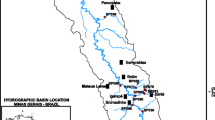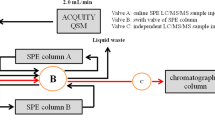Abstract
In this work, a multi-class analytical method for determination of 22 frequently used pharmaceuticals was developed and validated. Analytes were from different classes for example macrolides, fluoroquinolones, tetracyclines, sulfonamides, anthelmintics, anesthetics, and others. Method was intended for analysis of aqueous samples so the sample preparation was done using solid-phase extraction (SPE). Different sorbents (C8, C18, polymeric, and ion exchange sorbents) combining different eluents (methanol, ethanol, acetonitrile, acetone, ethyl acetate) were investigated during development of sample preparation step. Samples were analyzed using HPLC-MS/MS, and therefore, chromatographic and mass spectrometer conditions were investigated. Optimal extraction efficiencies for most of the investigated analytes were obtained with Oasis HLB polymeric sorbents with acetonitrile as eluent. A study of matrix effect was carried out for wastewater treatment plant (WWTP) influent and effluent. The method was validated for linearity, detection limits and quantification limits, repeatability, and reproducibility. Method detection limits were in the range of 2.0–204.0 ng L−1 for WWTP influent except for sulfaguanidine and dexamethasone. Also, method detection limits for WWTP effluent were from 1.0 to 115.4 ng L−1. Method was successfully applied for analysis of real wastewater samples from municipal wastewater treatment plant. In the influent, pharmaceuticals from all investigated groups were present and the concentrations were from 50.0 to 4914.3 ng L−1 for influent and 26.9 to 1699.2 ng L−1 for effluent. It was also reported that some pharmaceuticals showed higher concentrations in the wastewater effluent than in the influent.








Similar content being viewed by others
References
Abuin S, Codony R, Compano R, Granados M, Prat MD (2006) Analysis of macrolide antibiotics in river water by solid-phase extraction and liquid chromatography-mass spectrometry. J Chromatogr A 1114:73–81
Bottoni P, Caroli S, Caracciolo AB (2010) Pharmaceuticals as priority water contaminants. Toxicol Environ Chem 92:549–565
Bueno MJM, Gomez MJ, Herrera S, Hernando MD, Agüera A, Fernández-Alba AR (2012) Occurrence and persistence of organic emerging contaminants and priority pollutants in five sewage treatment plants of Spain: two years pilot survey monitoring. Environ Pollut 164:267–273
Gobel A, McArdell CS, Jos A, Siegrist H, Giger W (2007) Fate of sulfonamides, macrolides and trimethoprim in different wastewater treatment technologies Science of Total. Environment 372:361–371
Gosetti F, Mazzucco E, Zampieri D, Gennaro MC (2010) Signal supression/enhancment in high-performance liquid chromatography tandem mass spectrometry. J Chromatogr A 1217:3929–3937
Grabic R, Fick J, Lindberg RH, Fedorova G, Tysklind M (2012) Multi-residue method for trace level determination of pharmaceuticals in environmental samples using liquid chromatography coupled to triple quadrupole mass spectrometry. Talanta 100:183–195
Gracia-Lor E, Martinez M, Sancho JV, Penuela G, Hernandez F (2012) Multi-class determination of personal care products and pharmaceuticals in environmental and wastewater samples by ultra-high performance liquid chromatography-tandem mass spectrometry. Talanta 99:1011–1023
Gros M, Petrović M, Barcelo D (2006a) Development of a multi-residue analytical methodology based on liquid chromatography-tandem mass spectrometry (LC-MS/MS) for screening and trace level determination of pharmaceuticals in surface and waste waters. Talanta 70:678–690
Gros M, Petrović M, Barceló D (2006b) Multi-residue analytical methods using LC-tandem MS for the determination of pharmaceuticals in environmental and wastewater samples: a review. Anal Bioanal Chem 386:941–952
Gros M, Petrović M, Ginebreda A, Barceló D (2010) Removal of pharmaceuticals during wastewater treatment and environmental risk assessment using hazard indexes. Environ Int 36:15–26
Gros M, Rodrigez-Mozaz S, Barcelo D (2013) Rapid analysis of multiclass antibiotic residues and some of their metabolites in hospital, urban wastewater and river water by ultra-high-performance liquid chromatography coupled to quadrupole-linear ion trap tandem mass spectrometry. J Chromatogr A 1292:173–188
Gros M, Rodríguez-Mozaz S, Barceló D (2012) Fast and comprehensive multi-residue analysis of a broad range of human and veterinary pharmaceuticals and some of their metabolites in surface and treated waters by ultra-high-performance liquid chromatography coupled to quadrupole-linear ion trap tandem mass spectrometry. J Chromatogr A 1248:104–121
Horvat AJM et al (2012) Analysis, occurrence and fate of anthelmintics and their transformation products in the environment. Trends Anal Chem 31:61–84
Igos E, Benetto E, Venditti S, Kohler C, Cornelissen A, Moeller R, Biwer A (2012) Is it better to remove pharmaceuticals in decentralized or conventional wastewater treatment plants? A life cycle assessment comparison. Sci Total Environ 438:533–540
Jones OA, Lester JN, Voulvoulis N (2005) Pharmaceuticals: a threat to drinking water? Trends Biotechnol 23:163–167
Lapworth DJ, Baran N, Stuart ME, Ward RS (2012) Emerging organic contaminants in groundwater: a review of sources, fate and occurrence. Environ Pollut 163:287–303
Li WC (2014) Occurrence, sources, and fate of pharmaceuticals in aquatic environment and soil. Environ Pollut 187:193–201
Matuszewski BK (2006) Standard line slopes as a measure of a relative matrix effect in quantitative HPLC–MS bioanalysis. J Chromatogr B 830:293–300
Matuszewski BK, Constanzer ML, Chavez-Eng CM (2003) Strategies for the assessment of matrix effect in quantitative bioanalytical methods based on HPLC-MS/MS. Anal Chem 75:3019–3030
Nödler K, Licha T, Bester K, Sauter M (2010) Development of a multi-residue analytical method, based on liquid chromatography–tandem mass spectrometry, for the simultaneous determination of 46 micro-contaminants in aqueous samples. J Chromatogr A 1217:6511–6521
Qiang Z, Adams C (2004) Potentiometric determination of acid dissociation constants (pKa) for human and veterinary antibiotics. Water Res 38:2874–2890
Rua-Gomez PC, Puettmann W (2012) Impact of wastewater treatment plant discharge of lidocaine, tramadol, venlafaxine and their metabolites on the quality of surface waters and groundwater. J Environ Monit 14:1391–1399
Seifrtová M, Nováková L, Lino C, Pena A, Solich P (2009) An overview of analytical methodologies for the determination of antibiotics in environmental waters. Anal Chim Acta 649:158–179
Senta I, Terzić S, Ahel M (2013) Occurence and fate of dissolved particulate antimicrobials in municipal wastewater treatment. Water Res 47:705–714
Steene JCVD, Lambert WE (2008) Comparison of matrix effects in HPLC-MS/MS and UPLC-MS/MS analysis of nine basic pharmaceuticals in surface waters. J Am Soc Mass Spectrom 19:713–718
Taylor D, Senac T (2014) Human pharmaceutical products in the environment—the “problem” in perspective. Chemosphere 115:95–99
Taylor PJ (2005) Matrix effects: the Achilles heel of quantitative high-performance liquid chromatography-electrospray-tandem mass spectrometry. Clin Biochem 38:328–334
Terzić S et al (2008) Occurrence and fate of emerging wastewater contaminants in Western Balkan Region Science of Total. Environment 399:66–77
Watkinson AJ, Murby EJ, Costanzo SD (2007) Removal of antibiotics in conventional and advanced wastewater treatment: Implications for environmental discharge and wastewater recycling. Water Res 41:4164–4176
Wille K, Claessens M, Rappé K, Monteyne E, Janssen CR, Brabander HFD, Vanhaecke L (2011) Rapid quantification of pharmaceuticals and pesticides in passive samplers using ultra high performance liquid chromatography coupled to high resolution mass spectrometry. J Chromatogr A 1218:9162–9173
Yang S, Cha J, Carlson K (2005) Simultaneous extraction and analysis of 11 tetracycline and sulfonamide antibiotics in influent and effluent domestic wastewater by solid-phase extraction and liquid chromatography-electrospray ionization tandem mass spectrometry. J Chromatogr A 1097:40–53
Zhou JL, Maskaoui K, Lufadeju A (2012) Optimization of antibiotic analysis in water by solid-phase extraction and high performance liquid chromatography–mass spectrometry/mass spectrometry. Anal Chim Acta 731:32–39
Zrnčić M, Gros M, Babić S, Kaštelan-Macan M, Barcelo D, Petrović M (2014) Analysis of anthelmintics in surface water by ultra high performance liquid chromatography coupled to quadrupole linear ion trap tandem mass spectrometry. Chemosphere 99:224–232
Acknowledgements
This study has been fully supported by the Croatian Science Foundation under the project Fate of pharmaceuticals in the environment and during advanced wastewater treatment (PharmaFate) (IP-09-2014-2353).
Author information
Authors and Affiliations
Corresponding author
Additional information
Responsible editor: Ester Heath
Electronic supplementary material
ESM 1
(DOCX 512 kb)
Rights and permissions
About this article
Cite this article
Čizmić, M., Babić, S. & Kaštelan-Macan, M. Multi-class determination of pharmaceuticals in wastewaters by solid-phase extraction and liquid chromatography tandem mass spectrometry with matrix effect study. Environ Sci Pollut Res 24, 20521–20539 (2017). https://doi.org/10.1007/s11356-017-9660-7
Received:
Accepted:
Published:
Issue Date:
DOI: https://doi.org/10.1007/s11356-017-9660-7




